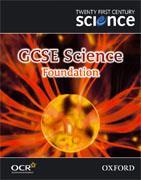Stuart Walker reviews thise set of differentiated books
Twenty first century science: GCSE science foundation and higher student books
University of York Science Education Group and Nuffield Curriculum Centre
Oxford: OUP 2006 | Pp240, 272 | £15.00, £16.00 | ISBN 0 19 915022 2, ISBN 0 19 915024 9
Reviewed by Stuart Walker

The curriculum for GCSE students has recently undergone significant changes to make the study of science more applicable and relevant to a wider range of students. One of the major changes has been to remove some scientific course content and shift the focus to a more vocational, skills-based approach to understanding contemporary scientific issues. This set of differentiated books has been written by 15 distinguished authors as an accompanying text for Key Stage 4 students studying the new OCR GCSE Twenty first century science course launched this month.
The books are broken down into chapters that correspond to the modules outlined in the OCR specification. Each chapter begins with a useful introduction which briefly explains what the students will study, what scientific skills they will gain and importantly, why they must study it. The chapters are well-written and illustrated, using a variety of photos and illustrations. Each topic is delivered in relevant and logical steps. Each double-page spread includes student-friendly features such as key word lists and 'find out about' boxes, which list the specifics of what the student is learning. The latter feature is particularly useful for teachers because these can easily form the basis of the learning objectives that students must meet throughout the course. All double-page spreads include question boxes that incorporate a wide variety of open-ended questions, which encourage students to think around the topic and form opinions based upon the evidence given in the text.
Differentiation between the books is mainly in the level of the course content and the choice of questions. However, the higher tier book misses out on opportunities to stretch the more able student, which could have been achieved by incorporating challenging questions and facts into the text. The lack of any regular summary is also a disadvantage of both books. Although the books are admirably attempting to encourage students to form opinions on open-ended scientific topics, I feel that the lack of a regular recap to distil the knowledge and issues into understandable key points could leave lower ability students adrift.
Costing £15 and £16, respectively, the books are a little pricey, but overall, the pair will be a useful part of the plethora of resources that teachers will use to deliver the new OCR GCSE Science specification. The only question mark hanging over these high quality textbooks is whether they can effectively meet the needs of a wide range of students.






No comments yet